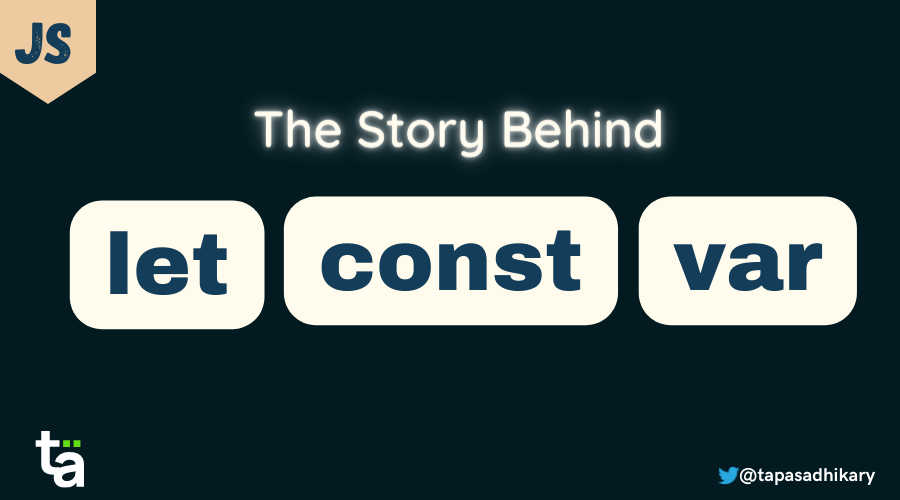As a JavaScript beginner, you probably learned how to declare variables and assign values.
In the old, pre-ES6 era of JavaScript, developers used to declare variables using the keyword var or without any keywords. But times have changed!
With ES6 (EcmaScript 2015), the beginning of the modern era in JavaScript, the language got two new keywords to help us declare variables. These are let and const.
In this article, we will learn about all of these keywords (yes, including var) with examples, and we'll see when to use them, and when not to use them.
If you like to learn from video content as well, this article is also available as a YouTube video tutorial here: 🙂
Btw, this is a widely discussed topic. Then, why write about it again? Well, these keywords can be tough to learn because:
- Many devs try using them interchangeably(especially
letwith the other two). - At times, you may get confused about the relationship of these keywords to a fundamental JavaScript concept called
Scope.
So, this article aims to teach these keywords in the context of three essential concepts. I hope you enjoy reading it.
How to Declare Variables in JavaScript
In JavaScript, we can declare variables in three different ways like this:
// Without keywords. It is essentially the same as var
// and not allowed in 'strict' mode.
name = 'Jack';
// Using var
var price = 100;
// Using let
let isPermanent = false;
// Using const
const PUBLICATION = 'freeCodeCamp'
It is best when you understand var, let, and const with these three concepts:
- Scope
- Reassigning a new value
- When you access a variable before declaring it
These keywords differ in usage in respect to these concepts. Let's see how.
Variable Scope in JavaScript
In JavaScript, we use scope as a way to identify where and whether we can use a variable. The variables may exist within a block, inside a function, or outside a function and block.
So, what is a block? A block (that is, a code block) is a section of the code we define using a pair of curly brace s({...}). Something like this:
{
let name = "alex";
}
On the other hand, a function is a bunch of code instructions you want to place logically together.
Usually, you define a function using the function keyword and a name. Just be aware that you can define a function without a name, which we call an anonymous function. But we won't discuss that in today's article for simplicity.
Here is a function with the name test.
function test() {
let name = "alex";
}
Anything and everything outside of a block or a function we'll call Global. So, when we declare variables, they can exist within a block, inside a function, or outside of a block/function – that is, they have global scope.
There are mainly three types of scope:
- Block Scope
- Functional Scope
- Global Scope
The three keywords var, let, and const work around these scopes. So let's understand how things fit together.
How to Use JavaScript Variables in Block Scope
If you do not want a variable declared inside a { } block to be accessed outside of the block, you need to declare them using the let or const keywords. Variables declared with the var keyword inside the { } block are accessible outside of the block too. So, be careful.
Let's take an example:
{
let f_name = 'Alex';
const ZIP = 500067;
var age = 25;
}
console.log(f_name); // Uncaught ReferenceError: f_name is not defined
console.log(ZIP); // Uncaught ReferenceError: ZIP is not defined
console.log(age); // 25As you see, the value of the age variable may get overridden unknowingly and eventually introduce a bug. So, the moral of the story is,
Do not use thevarkeyword inside a block (block scope). Always useletandconstinstead.
How to Use JavaScript Variables in Functional Scope
A variable declared inside a function using these keywords is not accessible outside the function. That's the applied functional scope.
It is true irrespective of whether you use var, let, or const. Inside the function, they are pretty similar in managing a variable's scope.
Let's take an example again:
// f1() is a function
function f1() {
let f_name = "Alex";
const ZIP = 560089;
var age = 25;
}
f1();
console.log(f_name); // Uncaught ReferenceError: f_name is not defined
console.log(ZIP); // Uncaught ReferenceError: ZIP is not defined
console.log(age); // Uncaught ReferenceError: age is not definedAs you see above, none of the variables are accessible outside of the function, not even age which is declared using var. So, the conclusion is,
The variable declared withvarinside a function is not accessible outside of it. The keywordvarhas function-scope.
How to Use JavaScript Variables in Global Scope
Variables declared outside of any functions and blocks are global and are said to have Global Scope. This means you can access them from any part of the current JavaScript program.
You can use var, let, and const to declare global variables. But you shouldn't do it too often.
let f_name = "Alex";
const ZIP = 560089;
var age = 25;
// f1() is a function
function f1() {
console.log(f_name); // Alex
console.log(ZIP); // 560089
console.log(age); // 25
}
f1();
console.log(f_name); // Alex
console.log(ZIP); // 560089
console.log(age); // 25As you see, the variables are accessible everywhere.
So, to restrict the scope of a variable using the var, let, and const keywords, here's the order of accessibility in scope starting with the lowest:
var: The functional scope levellet: The block scope levelconst: The block scope level
The image below shows a mindmap of these three keywords with reference to different scopes.

Let's move on to the next concept to understand how these three keywords influence the code's behavior when we reassign a new value to a variable.
How to Reassign a New Value to a Variable in JavaScript
Once you've declared a variable with var or let, you can reassign a new value to the variable in your programming flow. It is possible if the variable is accessible to assign a value. But with const, you can't reassign a new value at all.
// Declare variables with initial values
let f_name = "Alex";
const ZIP = 560089;
var age = 25;
// Reassign values
f_name = "Bob"; // the f_name value is 'Bob"
ZIP = 65457; // Uncaught TypeError: Assignment to constant variable.
age = 78; // the age value is 78There is a tricky part with const that you must be aware of. When an object is declared and assigned a value with const, you can still change the value of its properties. But you can not reassign another object value to the same variable. This is a common mistake many devs make.
Check out the example here:
const blog = {
'url': 'https://greenroots.info'
}
blog.url = 'https://blog.greenroots.info"; //Allowed
blog = {}; // Uncaught TypeError: Assignment to constant variable.Here is a mindmap to help you grasp how reassigning works for variables declared with these three keywords.

What Happens When You Access a Variable Before Declaring it in JavaScript
As a pragmatic programmer, you should never try accessing a variable without declaring it. But in case it happens, let's see how the variable may behave.
With var in non-strict mode, the variable will have an undefined value. This means that a variable has been declared but has no value assigned.
In strict mode, you will get a ReferenceError that the variable is not declared.
With let and const, if you try to access a variable before declaring, you will always get a ReferenceError.
Here is a mindmap again to help you understand it visually. In the mindmap, var is depicted for non-strict mode.

That's all, my friends. You need to consider these circumstances and concepts to evaluate how var, let, and const behave. So, the rule goes:
- Don't use
varanymore. - Use
letorconst. - Use
constmore often. Useletwhen you need to reassign another value to a variable. - Don't try to access a variable without declaring it.
Before We End...
That's the story behind let, const, and var. I hope you found the article insightful and informative. My DMs are open on Twitter if you want to discuss further.
Let's connect. I share my learnings on JavaScript, Web Development, and Blogging on these platforms as well:
See you soon with my next article. Until then, please take care of yourself, and stay happy.

